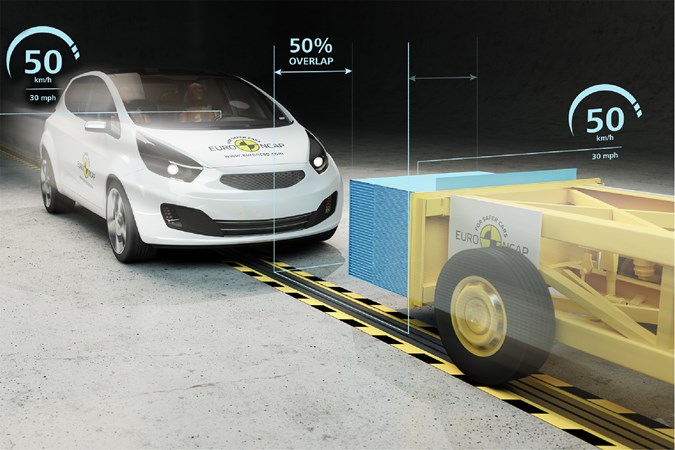With so many cars achieving five-star ratings, and those that don’t largely failing to do so because of the technology rather than the crash protection, Euro NCAP‘s meaning has changed. New test methods will make it more useful for all road users.
Since shifting to a simple five-star rating, Euro NCAP has become less of a marker of how fundamentally safe your car is in an accident, and more of an indication of how much the car will do to prevent one if your attention slips.
One failing of the current standards, however, is that the test objects don’t judge how much impact the crashing car has on what it hits.
Common sense dictates that if a large SUV hits an older, smaller car, the results could be devastating for someone – just, not the occupants of the newer car.
Mobile Progressive Deformable Barrier
In place of the fixed deformable barrier used in offset crashes, a 1,400kg trolley with deformable front moves to collide with the moving crash test car. They’re both travelling at 50km/h (31mph), for a typical urban offset head-on crash scenario.

In addition to the usual test data, this crash establishes a new parameter – ‘compatibility’ – which gives an idea of how much impact the test car could have on other vehicles.
Fully instrumented dummies, two ‘male’ in the front seats, and two ‘child’ in the rear, provide data for the test car. The trolley instrumentation measures deceleration, in addition to the damage to the deformable area, allows the safety of the tested car in the real world to be judged.
Far-side impact
Not a reference to a Gary Larson comic, the far-side impact tests expand the scope of the test to judge how well occupants on the opposite side of the crash fare, particularly in light of centre console airbags and additional protection for the driver that may not be offered to the passenger.
This test also assesses how the driver and passenger dummies interact in the side impact where central airbags and other countermeasures are installed.
Technology updates
Driver assistance such as occupant status monitoring – fatigue and distraction detection as well as less sophsticated features like seatbelt monitors – joins the existing suite of tests for autonomous features and vulnerable road user detection.
Post crash and rescue tests
Although Euro NCAP hasn’t ignored how easy it is to rescue occupants from a crashed car safely, the new tests rate clarity of information for Fire and Rescue services, ease of access post-crash, and functionality of things such as electric door handles.
Why do Euro NCAP tests change, but the scores stay the same?
One of the biggest factors in standardised testing of this type, when it becomes a significant marketing tool, is the tendency to design to get the highest score, regardless of the impact this has on other vehicles on the road.We’ve seen a dramatic shift in the technology used in car bodies, and it’s why developing markets sometimes seem so far behind when following a natural path engineering improvements.
Every two years, standards are refined – sometimes ignoring crash performance entirely in favour of new technology – but the last big update redefined the boundaries for injuries. Revising those ratings down for previous cars would be unfair and unworkable – so Euro NCAP scores are only truly comparable against cars of the same age.
It’s worth remembering though, that the injury thresholds for adults have been very good since the mid-2000s. Few modern, well-maintained cars are unsafe in the traditional sense of the word, but newer ones with higher scores are definitely better.
What does this mean for you?
In car safety, designing for crash protection is a good thing of course – but it has lead to something of an arms race, with bigger, heavier and more modern cars performing best against the test barriers, but posing a greater risk in the real world.
Euro NCAP has ensured valuable considerations such as child occupant safety, child seat performance and autonomous emergency braking are independently verified to be effective, too.
This market visibility has ensured buyers are drawn to these safer models, often at the expense of efficiency and emissions. Though cars are considerably safer now than had it purely been down to in-house testing and mandatory standards, the range of real-world crashes Euro NCAP can reflect is limited.
Now, the crash tests will also reflect how much damage your car could inflict on the occupants of another car in an accident.
Further reading:
>> How crash test standards have improved – video
>> Final results of 2019: Euro NCAP
Just so you know, we may receive a commission or other compensation from the links on this website - read why you should trust us.


